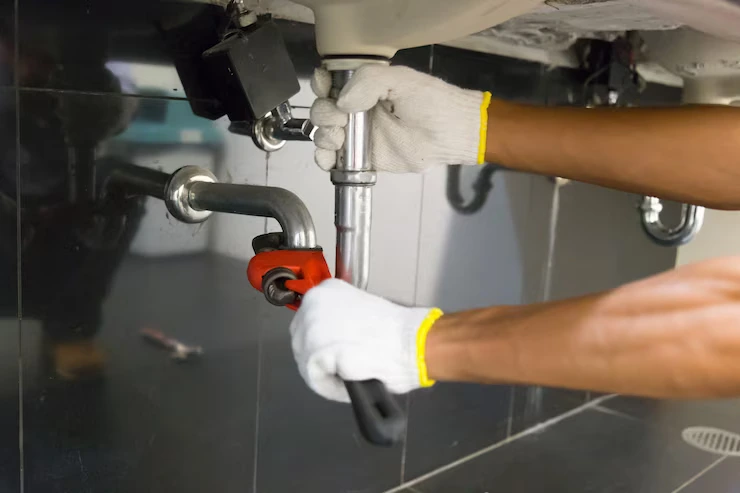Preparing for cold weather is an essential task for homeowners, and one area that often gets overlooked is leak prevention for pipes. As temperatures drop, the risk of pipes freezing and bursting increases, leading to costly repairs and water damage.
Winter is just around the corner, and the potential threat of frozen pipes comes with it. As the temperature drops, it’s important to take proactive measures to prevent leaks and avoid costly repairs.
As winter approaches, many homeowners face the task of preparing their homes for the cold weather. One crucial aspect of winter preparedness is leak prevention, particularly when protecting pipes. Cold temperatures can cause pipes to freeze and potentially burst, leading to costly damages and inconveniences.
To help you prevent this costly and inconvenient problem, we have compiled 5 leak prevention tips to prepare your pipes for the cold weather.
1. Insulate your pipes:
When it comes to protecting your pipes from freezing temperatures, insulating them is one of the simplest and most effective methods. By creating a barrier, insulation helps to retain the heat inside the pipes, preventing them from getting too cold.
Not only does this minimize the risk of freezing, but it also drastically reduces the chances of pipes bursting and causing costly water damage to your property. Insulating your pipes is an essential step in leak prevention.
To insulate your pipes effectively, you have a few options at your disposal. One popular choice is foam pipe insulation, which can quickly be wrapped around exposed pipes.
This type of insulation is particularly beneficial in unheated areas like basements, attics, or crawl spaces, where pipes are more susceptible to freezing. Foam pipe insulation provides an extra layer of protection, helping maintain the water’s temperature flowing through your pipes.
2. Seal any cracks or gaps:
As the colder months approach, protecting your home and ensuring your pipes don’t freeze is important. One of the most effective ways is by sealing cracks or gaps where cold air can enter your home. Not only will this help keep your pipes safe, but it will also improve the overall energy efficiency of your home.
Cold air has a sneaky way of finding its way into your home through small cracks or gaps in the walls, windows, or doors. These seemingly insignificant openings can lead to a significant drop in temperature inside your home, which increases the risk of your pipes freezing. So, inspecting your home thoroughly for any visible cracks or gaps is crucial.
Prepare for colder months by sealing cracks and gaps to protect your pipes and enhance energy efficiency. Cold air can enter through these openings, increasing the risk of frozen pipes. Inspect walls, windows, and doors, then seal with caulk. For plumbing help, visit Rørleggervakt.eu to find the best plumber.
3. Allow faucets to drip:
As the temperatures continue to drop during the winter months, homeowners face the risk of frozen pipes, which can lead to costly repairs and water damage. However, a simple and effective solution can help prevent this issue – allowing your faucets to drip. While it may seem counterintuitive to let water run, this method can be a lifesaver for your plumbing system.
When the mercury plummets and freezing temperatures set in, stagnant water in your pipes becomes susceptible to freezing. This can create pressure within the pipes, leading to cracks, leaks, or bursts. By allowing your faucets to drip slightly, you can keep the water in your pipes flowing, reducing the risk of freezing and potential pipe damage.
Moving water is less likely to freeze compared to stagnant water. Keeping a small stream of water running through your faucets ensures the water is constantly in motion, making it less likely to reach freezing temperatures. This can help maintain the integrity of your pipes and prevent the need for costly repairs or replacements.
It’s important to note that this drip technique should only be used for faucets connected to exposed pipes. It is unnecessary for faucets connected to interior pipes that are insulated and protected from freezing temperatures. By focusing on exposed pipes, you can effectively utilize this method without excessive water wastage.
4. Keep your home warm:
Maintaining a warm temperature inside your home is essential for comfort and prevents frozen pipes. Frozen pipes can cause significant damage to your plumbing system and lead to costly repairs. By following a few simple steps and implementing proper leak prevention measures, you can ensure that your home stays warm and your pipes remain intact.
One of the first steps to prevent frozen pipes is setting your thermostat to a consistent temperature. Even when you’re away, keeping the heat circulating throughout your home and reaching the pipes is important. This ensures the temperature remains above freezing, preventing potential freezing and subsequent pipe bursting.
Suppose you plan to be away from your home for an extended period during the winter. Setting your thermostat to a minimum temperature, still above freezing. Doing so provides extra protection to your pipes and reduces the risk of them freezing. This simple precaution can go a long way in preventing leaks and potential water damage.
5. Drain and disconnect outdoor hoses:
As the winter season approaches, it’s important to take the necessary steps to protect your home from potential damage. One area that often gets overlooked is the outdoor hoses. These seemingly harmless tools can cause significant damage if not properly maintained during the colder months.
Outdoor hoses are particularly susceptible to freezing during the winter months. When water freezes, it expands, which can cause hoses to crack or burst. Not only can this lead to the requirement for exorbitant fixes or substitutions, but it can likewise harm the associated lines and apparatuses. You can stay away from these issues by taking a couple of basic protection measures.
The first step in leak prevention is to drain all outdoor hoses before the cold weather sets in. Start by shutting off the water supply to the hose and opening the nozzle to release any remaining water. Allow the hose to drain completely before coiling it up for storage. Removing all the water from the hose eliminates the risk of freezing and subsequent damage.
The Verdict
Preparing for cold weather should always include leak prevention for pipes. With the risk of freezing and bursting increasing as temperatures drop, homeowners must take proactive measures to avoid costly repairs and water damage.
As winter approaches, it is crucial to prioritize leak prevention and protect pipes to prevent inconveniences and potential financial burdens. By taking the necessary steps to prepare for winter, homeowners can ensure that their pipes remain intact and their homes are protected from the damaging effects of frozen pipes.




